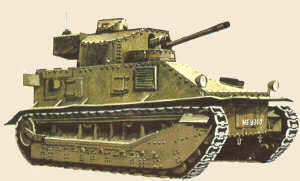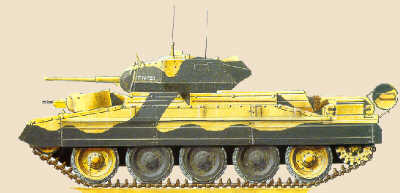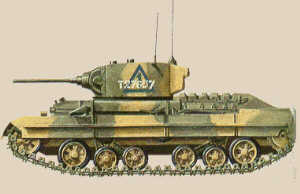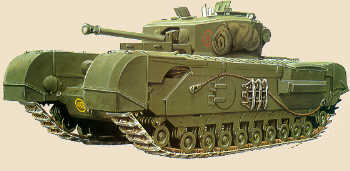| A World of Tanks |
United Kingdom
![]()
 |
Light Tank Mk VI |
| The Light Tank marks began in 1931 as a development of earlier
experimental designs which could be traced back to the Carden-Lloyd tankettes. Early Light
Tank marks (from I to IV) had two-man crews, increased to three with the Mark V. Although
the speed and fair reliability of the Light Tanks compensated their poor armour and
firepower, they proved of limited combat value, even in reconnaissance role. After 1942 the Light Tanks were withdrawn as soon as possible and replaced by Stuarts.
|
 |
Vickers Medium |
| In 1923 the Vickers Ltd designed a new tank denominated Medium Tank
Mark I but generally referred to as the Vickers Medium . It was actually the only tank supplied to the Royal Tank Corps during the 1920s.Total production amounted to 160 units.
|
 |
Vickers 6.0 ton |
| The Vickers 6.0 ton is the actual example that "Nemo
Propheta in Patria" In spite of its technical and economical merits it was, in fact, not considered worthwhile by the British Headquarters. A different consideration was instead given to this medium tank by other countries : the 6- tonner was sold to 18 countries, licensed to 4 countries,...and brutally copied by at least 10 other countries! (the above image is that of a F type deployed by the Chinese Army)
|
 |
Cruiser Mk I |
| Designed in 1936, the Cruiser Mk I by Vickers
Armstrong was a considerable advance over other British tanks of the era such as the
Vickers Medium. It had a hydraulic powered traversing mechanism for the main turret and a
very good three-wheel bogie suspension. There were, however, carry-overs from earlier
models, like the two MG turrets in the front hull, which led to increase the crew number
to 6. In spite of the good start, by 1940 the Mk I was inadequate for the protection, firepower, speed and cross country standards required by the war. All the Mk I sent to France (1940) and to Greece (1941) were lost. In North Africa Cruiser Mk I had to soldier on well into 1942.
|
 |
Cruiser Mk IV |
| The Cruiser Mk IV was the most important British tank
(numerically) of the early war years. It adopted, as well as that of its predecessor Cruiser
Mk III, the Christie suspension which improved the poor off-road performance of
the early Cruiser marks. Both Mk III and Mk IV were not a success as their armour was too light and the 2-pounder main gun inadequate. Production ceased in 1941 after 65 Mk III and 655 Mk IV had been delivered.
|
 |
Cruiser Mk V Covenanter Weight : 18.2 ton |
| The Cruiser Mk V was basically an A13 reworked to remove the
mechanical problems which had affected the performance of the Cruiser Marks III and IVs. The new design featured a very good steering system and a "flat-12" engine for reducing the tank's height. The new engine, however, created additional cooling problems which required four different marks before they were solved. Total production was 1,771 but the Covenanters were never committed to battle
and served as training vehicles. They were withdrawn during 1943. |
 |
Cruiser Tank Mk VI "Crusader II" |
| The Crusader II formed the main equipment of the British armoured
divisions in the Desert Campaigns. It was a fairly reliable vehicle, specially if one
considers the disappointing performances of its predecessors (the Cruiser Mk III
and IV, the Covenanter, and the Crusader I). Total production amounted to 5,300 units. Crusaders were used also for a variety of special purposes including observation post, command tank, ARVs, mine-clearing, anti-tank gun tractors, and more...
|
 |
Cruiser Tank "Cromwell" |
| The Cromwell was the first British tank to have a reliable engine (the
Rolls Royce Meteor). Production started at Leyland Motors arsenal from mid-1943
onwards. The Cromwell, with its well-tried suspension, powerful engine, and good protection gave the British tank crews the opportunity to be at par with their German opponents. It saw action from May 1944 onwards and became the most important, in both numerical and quality terms, of the British tanks.
|
 |
Cruiser Tank Comet |
| The Cruiser Tank Comet was in practice an enhanced Cromwell
but deserved a new name because the high number of design changes and new components
(first of all the adoption of the 17-pounder as main gun). The first were delivered in
December 1944 and during the last stages of the war they proved themselves both
battle-worthy and reliable. The Comet was the best British tank of the war years and serviced in many countries well over the 1960s
|
 |
Infantry Tank Mk I "Matilda" |
| The Matilda I was the first of the Infantry Tanks line of
vehicles, characterized by the emphasis placed on crew protection. The small Matilda's
designers had a twofold target : low cost and quick production rates. In spite of its excellent protection, the Matilda I was obsolete by 1939. Production ceased after 139 had been built.
|
 |
Infantry Tank Mk II "Matilda II" |
| The Matilda II, since its first appearance in 1940, was a great
success. Unlike other British tanks it was well-armoured (its armour was proof against
most German anti-tank weapons of the early war years) and mechanically reliable. It was,
however, very slow and, due to its small turret ring diameter, could not mount more than a
2-pounder gun. It was one of the North African campaign "victory makers". By the time production ceased in 1943, 2987 had been built.
|
 |
Infantry Tank Mk III "Valentine" |
| The prototype of Valentine, a more armoured development of the
Cruiser Tank MkI and MkII, was ready on February 14, 1940
(hence its name!). By the time production ceased in 1944, 8275 (a higher total than for
any other British tank) had been built. Valentine tanks proved to be reliable reliable vehicles, even if they were difficult to drive. Important variants included the Bishop, the Archer, and the Duplex Drive swimming tank systems.
|
 |
Infantry Tank Mk IV "Churchill Mk VII" |
| The Churchill Mk VII was a major redesign. The turret was
enlarged, with a commander's cupola, and dust guards fitted over the tracks. Armor was
increased (early marks' max armor was 112 mm). The Churchill was used for many "special roles" such as : Crocodile ( a flame-thrower), AVRE (a mortar used by Royal Engineers Corps to launch heavy demolition charge known as the Petard), bridge carriers, landing mats carrier, etc. Actually the Churchill fullfilled every role an armoured vehicle could be called upon to assume. |
![]()
![]() I'd be
delighted if you filled one page of my Guestbook
and let me have your comments
I'd be
delighted if you filled one page of my Guestbook
and let me have your comments
![]()
![]() Back to Klisura69
homepage
Back to Klisura69
homepage
Acknowledgment
All the color images (by G.Canestrari) and information have been selected from the "I
Corazzati" book by B.Benvenuti, edited by A.Mondadori, and from "TANKS of World
War Two" by J.Restayn, edited by Histoire & Collections . Further information was
extracted from "Tanks of World War II", a handbook edited by COLLINS/Jane's.
All material is property of the respective authors
Page established on : July 22, 1997
Last update : January 20, 1998
This page is maintained by Mario Paesani .....the webmaster !
This page hosted by ![]() Get your own Free Home Page
Get your own Free Home Page